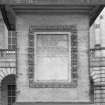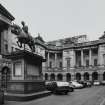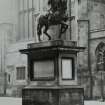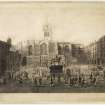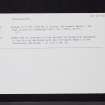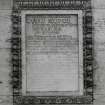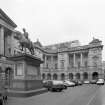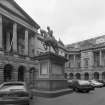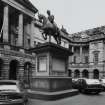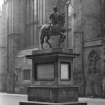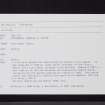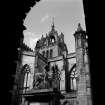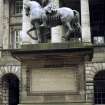Pricing Change
New pricing for orders of material from this site will come into place shortly. Charges for supply of digital images, digitisation on demand, prints and licensing will be altered.
Upcoming Maintenance
Please be advised that this website will undergo scheduled maintenance on the following dates:
Thursday, 9 January: 11:00 AM - 3:00 PM
Thursday, 23 January: 11:00 AM - 3:00 PM
Thursday, 30 January: 11:00 AM - 3:00 PM
During these times, some functionality such as image purchasing may be temporarily unavailable. We apologise for any inconvenience this may cause.
Edinburgh, Parliament Square, Statue Of Charles Ii
Statue (17th Century)
Site Name Edinburgh, Parliament Square, Statue Of Charles Ii
Classification Statue (17th Century)
Canmore ID 52292
Site Number NT27SE 271
NGR NT 25750 73551
Datum OSGB36 - NGR
Permalink http://canmore.org.uk/site/52292
- Council Edinburgh, City Of
- Parish Edinburgh (Edinburgh, City Of)
- Former Region Lothian
- Former District City Of Edinburgh
- Former County Midlothian
NT27SE 271 25750 73551
Oldest statue in Edinburgh, and possibly oldest lead equestrian statue in UK. Mylne's original pedestal of Craigleith stone. Statue completed within lifetime of the king (died 6 Febrary 1685), at cost of #2,580. Mylne was paid #938.14s. for pedestal. Height of statue c.8 feet from top of pedestal. Weight reputed to be c.6 tons.
A G Forgie 1952
Life-size equestrian lead statue of Charles II as Caesar. Supplied in 1685 by James Smith, Surveyor of the King's Works, probably imported from Holland. Pedestal 1835, a near replica of Robert Mylne's, incorporating marble inscription tablet of 1685. Statue restored in 1824-35 and again by H S Gamley, 1922, and E R Bevan, 1951-2.
J Gifford, C McWilliam and D Walker 1984
Painted white at the behest of the City Fathers, 1767. Following great fire of November 1924 spent nine years in storage in Calton jail.
M T R B Turnbull 1989.
NT27SE 271 25750 73551
ARCHITECT: Robert Mylne (pedestal), 1685.
REFERENCE: NMRS LIBRARY
Historical File -"Charles II Statue" -Historical Information
Publication Account (1951)
62. Statue of King Charles II, Parliament Square.
The equestrian figure of King Charles II which, in the words of a contemporary observer, represents him “formed in the Roman manner, like one of the Caesars, almost naked and so without spurs and without stirrups” (1), was intended to be setup during the monarch's lifetime. That is clear from the terms of the inscription, the allusion to the crushing of “the basilisk” indicating further that the scheme was launched on the wave of enthusiasm that swept the country after the discovery of the Rye-House plot in 1683. The statue was, however, completed only a month before his death, which took place in February, 1685, and cannot therefore have been erected until later. It is cast in lead, and is probably of Dutch origin. Robert Mylne, King's Master Mason, constructed “ane handsome and fyne pedestill” and the whole work cost three thousand five hundred and fifty-seven pounds two shillings and fourpence Scots exclusive of a gratuity to William Clerk, advocate,* for his pains in composing the lengthy Latin eulogium that has been cut in marble and affixed to the E. side of the base. At some date that has not been recorded, the inscription had to be removed for safety to a vault under the Parliament House and was not replaced until 1817. About 1824 statue and pedestal, both at that time in disrepair, were taken down to avoid damage during the construction of the buildings in Parliament Square and the rebuilding of St. Giles' Church. For some ten years the effigy stood inside the Calton Jail, but in 1835 after necessary repairs had been effected, it was re-erected in its original position, upon a new pedestal into which the marble panel containing the inscription was inserted. It was reconditioned in 1877 and again, more thoroughly, in 1922, when the figure was found to have been cast in one piece and soldered to the body of the horse, which had been cast in parts and built up on an oaken framework, the latter probably provided in replacement of the original iron armature during are furbishing which was carried out in 1830. The inscription runs :- Augustisimo (sic) Magnificentissimo / CAROLO SECUNDO / Britanniarum Galliarum & Hiberniae / MONARCHAE / INVICTISSIMO / Cujus Natalitis providentia arrisit Divina / Asterisco Meridianoeodem momento, conspicua (sic) / qui, post quam adolescentiam in acie, sub patre, exegisset / Illo demum obtruncato, Jus suum, per biennium / Strenue quidem, sed improspere vendicavit (sic) / Rebellioni Namq(ue) saepius victrici impar / solum prope per decennium vertere coactus est / in exterisautem Regionibus, divinis excubiis / [pactis dolis, minis, armis, Incubatoris / Non obstantibus]** munitus, & custoditus, / Instar SoIis tandem,clarioris e nubibus / In regna sua sine caede, expostliminio (sic) reversus / Ecclesiam politiam Civilem pacem Commercium / Erexit, auxit, firmavit, et stabilivit / Bello dein Batavico insignis, statim devenit / Inter bellantes vicinos belli pacisque Arbiter / Rebellione denique pristina nuper repullulante / Palladis non Martis ministerio Basiliscum / Inipso (sic) ovo compressit contudit et conculcavit / Huic ergo miraculorum principi summa in pace et Gloria . . . (" To Charles the Second, most august and most magnificent, the invincible ruler of Britain, France and Ireland, upon whose birth Divine Providence smiled at the very moment when a star was conspicuous in the noonday sky,*** and who, after a youth spent in arms under his father and after the latter had in the end been beheaded, maintained his own right for two years with energy indeed but without success; for unable to cope with a rebellion that was too often victorious, he was compelled to change his country for almost a decade. Abroad, however, despite the pacts, the wiles, the threats, and the military power of the Usurper, he was defended and protected by the watchfulness of Heaven, and at length emerging like the sun, all the brighter from the clouds that had enveloped him, here turned to his own realms without any shedding of blood and simply through recognition of his lawful claim, whereupon he established, enlarged, strengthened and confirmed the church, the state, peace and commerce. Then, winning fame by his war with Holland, he straightway became the arbiter of peace and war between his embattled neighbours. Finally, when the old rebellion recently showed signs of recrudescence, he checked the basilisk while it was still in embryo, crushed it and trod it underfoot by sheer sagacity and not by force of arms. To him, therefore, a prince of marvels, in a season of profound peace and at the height of his glory [this monument is erected]). Cf. also O.E.C., xvii, pp. 82-90.
RCAHMS 1951
(1) Lord Fountainhall, Historical Notices, 16th April, 1685.
*He received remission of cess of a hundred and thirty-one pounds Scots.
**The square brackets that enclose the words pactis . . ..obstantibus appear on the monument.
***None of the comets for which orbits have been computed appeared in 1630. A comet was observed in Italy in that year (Astronomische Nachrichten, xii, No. 277, of April 1835), but it is not known whether it was bright enough to be seen in daylight. It is possible that the object referred to in the inscription may have been a very bright meteor.
Project (1997)
The Public Monuments and Sculpture Association (http://www.pmsa.org.uk/) set up a National Recording Project in 1997 with the aim of making a survey of public monuments and sculpture in Britain ranging from medieval monuments to the most contemporary works. Information from the Edinburgh project was added to the RCAHMS database in October 2010 and again in 2012.
The PMSA (Public Monuments and Sculpture Association) Edinburgh Sculpture Project has been supported by Eastern Photocolour, Edinburgh College of Art, the Edinburgh World Heritage Trust, Historic Scotland, the Hope Scott Trust, The Old Edinburgh Club, the Pilgrim Trust, the RCAHMS, and the Scottish Archive Network.
Field Visit (16 October 2000)
Equestrian statue of Charles II in Roman Emperor's dress, placed on a rectangular stone pedestal.
Inscriptions : On marble panel on east side of pedestal:
Augustisimo Magnificentissimo / CAROLO SECUNDO / Brtanniarum Galliarum et Hiberniae / MONARCHAE / INVICTISSIMO / Cujus Natalitijs providentia arrisit Divina / Asterisco Meridiano eodem momento, conspicua / qui, postquam adolescentiam in acie, sub patre, exegisset / Illo demum obtruncato, Jus suum, per biennium / Strenue quidem, sed improspere vendicavit / Rebellioni Namq. saepius victrici impar / Solum prope per decennium vertere coactus est / in exteris autem Regionibus, divinis excubiis / [pactis dolis, minis, armis, Incubatoris
Non obstantibus] munitus, & custoditus, / Instar solis tandem, clarioris e nubibus / In regna sua sine caede, expostliminio reversus / Ecclesiam politiam Civilem pacem Commercium / Erexit, auxit, firmavit, et stabilivit / Bello dein Batavico insignis, statim devenit / Inter bellantes vicinos belli pacisque Arbiter / Rebellione denique pristina nuper repullante / Palladis non Martis ministerio Basiliscum / Inipso ovo compressit contudit et conculcavit / Huic ergo miraculorum principi summa in pace et Gloria
[This has been translated as: TO THE MOST AUGUST, MOST MAGNIFICENT CHARLES THE SECOND OF BRITAIN, FRANCE AND IRELAND, MOST INVINCIBLE MONARCH Whose birth Divine Providence smiled upon at the same moment as a noonday star was seen. Who, after passing his youth on the field of battle under his father until his father's execution, claimed his right, vigorously indeed but unsuccessfully, for two years: for, being oftener unequal to victorious Rebellion, he was forced to go into exile for nigh ten years. But in foreign lands he was shielded and watched over by heavenly guards [despite the compacts, deceits, threats and arms of the Usurper]. At length, like as the Sun issues more clearly from the clouds, returning to his Kingdom, he recovered his rights without bloodshed. He set up, enlarged, established and confirmed Church, Civil Polity, Peace and Commerce. Then, in the Dutch War, he at once became illustrious: between neighbouring warring nations he was Arbiter of War and Peace. And at last the old Rebellion breaking out again, he, by the help of Pallas, not of Mars, choked, crushed and trampled underfoot the Basilisk in the very eggs. To him, therefore, the Chief of Wonders, Highest in Peace and Glory, [this monument is dedicated].
Signatures : None
Year of unveiling : 1685
Information from Public Monuments and Sculpture Association (PMSA Work Ref : EDIN0188)



















